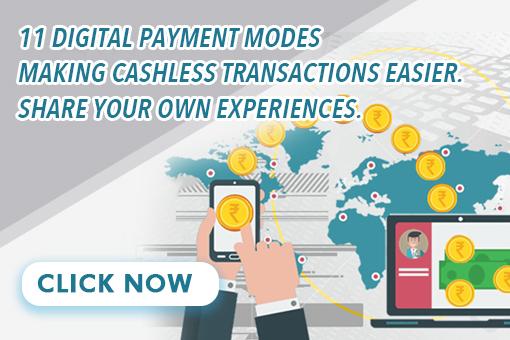Open Forum
- Department of Art & Culture
- Creative Corner
- Department of Agriculture
- Department of Education
- Department of Fisheries
- Department of Horticulture & Soil Conservation
- Department of Information Technology
- Department of MAHUD
- Department of Science & Technology
- Department of Sericulture
- Department of Tourism
- Department of Trade Commerce & Industries
- Department Of Transport
- Directorate of Health Services
- Finance Department
- Forest Department, Government of Manipur
- General Administration Department
- Imphal Municipal Corporation
- Manipur Fire Service
- Manipur Police Housing Corporation Limited (MPHC Ltd.)
- Open Forum
- Social Welfare Department
11 Digital Payment Modes Making Cashless Transactions Easier. Share your experiences.
Start Date: 14-10-2019
End Date: 14-11-2019
Today, Digital Payment covers a significant percentage in the payment sphere of the country ever since the evolution of the latest technologies and applications after Digital India ...
Hide details













Bhawna 6 years 2 months ago
6. IMPS
IMPS, which stands for Immediate Payment Service, is a service that was initiated by the National Payment Corporation of India. The pre-condition to avail IMPS services is that a user needs to also register for mobile banking. Once registered, the user may avail of the IMPS service even through internet banking. Money can be sent or received 27*7, and there is no cut-off time for transactions. IMPS can be done using the receivers MMID or IFSC code and bank account no.
Bhawna 6 years 2 months ago
5. NEFT & RTGS
National Electronic Fund Transfer and Real Time Gross Settlement are electronic payment systems that allow convenient fund transfer between bank accounts. Both facilities are maintained by the RBI (Reserve Bank of India). The facilities can be used to transfer money only within India. The RTGS transfer window is from 8 am to 4.30pm on weekdays and bank working days. NEFT settlements happen in deferred batches between 8 am to 7 pm on bank working days.
Bhawna 6 years 2 months ago
4. Mobile Wallets
Mobile wallets have become a convenient way of making payments without cash. Once you load money into your mobile wallet, you can use it wherever it is accepted. The most popular mobile wallet that is trending is Paytm. The disadvantage with mobile wallets is that it isn’t linked to your account. Once you load the money into your mobile wallet, you can only spend it with a merchant who accepts payment through the said app.
Bhawna 6 years 2 months ago
3. UPI Applications
UPI stands for Unified Payment Interface. UPI has changed the way we transact. At the core of a UPIs functionality is the fact that our mobile numbers are registered with our respective banks and linked to our accounts. A virtual payment address helps to send or receive money without entering any bank related information. Merchants would need to have a current account to receive UPI payments. UPI applications that are currently popular are BHIM, PhonePe, Google Pay/ Tez,
Bhawna 6 years 2 months ago
2. Debit and Credit Cards
Debit and credit cards have caught on as a method of cashless trading. A debit card is considered by many to be safer because you are transacting with money in your account. The risk with a credit card is overspending. Debit and credit cards can be used to make purchases online as well as over-the-counter at a store.
Bhawna 6 years 2 months ago
1. Cheques and Demand Drafts
A cheque is one of the safest and oldest methods of cashless payment. A cheque is issued to a person or business for a specific amount. This cheque is deposited in the receiver’s bank, and the money is received through a payment processed by a clearinghouse. A demand draft is safer than a cheque because it cannot be defaulted or dishonoured, unlike a cheque.
Bhawna 6 years 2 months ago
Such operations are accurate, quicker, convenient, and certainly easier. Many are unwilling to accept that there are benefits to a cashless transaction simply because they cannot navigate their way around digital devices, or are just happier to transact using cash. Read on about an array of cashless transactions that simplify day-to-day trading.
Bhawna 6 years 2 months ago
A cashless transaction is an automated or online operation that may take place between two people, business, or organisations. A digital transaction is a cashless transaction which specifically involves no paper for completion of the transaction. Purchasing goods from e-commerce websites, signing of business contracts online, or even buying movie tickets through your smartphone app fall under the umbrella of digital transactions
Pooja Saini 6 years 2 months ago
UPI is very fast. It transfers money instantly. The UPI works 24 x 7. There is no restriction.The NEFT can take up to 12 hours for the fund transfer. But UPI is as fast as IMPS.
To transfer Fund through the IMPS and NEFT you have to go through the registration of new payee. Although UPI also requires this step, but you have not to wait after the registration. There are at least 30-minutes waiting period for the NEFT and IMPS registration. But UPI is instantly available.
Hindusree Tallapally 6 years 2 months ago
Below mentioned are the various modes of digital payments available today:
1. Banking Cards (Debit Card, Credit Card, Cash Card, Travel Cards, etc.)
2. USSD (Unstructured Supplementary Service Data) Banking
3. AePS (AADHAAR ENABLED PAYMENT SERVICE)
4. UPI (UNIFIED PAYMENT INTERFACE)
5. Mobile Wallets or E-Wallets
6. Banks Prepaid Cards
7. PoS (Point of Sale)
8. Internet Banking
9. Mobile Banking
10. Micro ATMs
11. QR Code